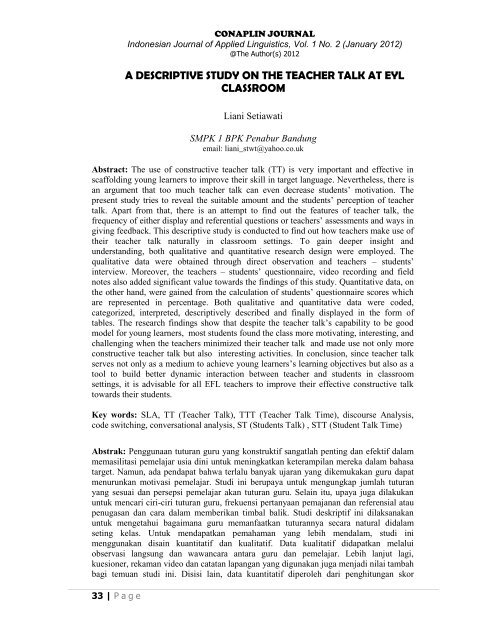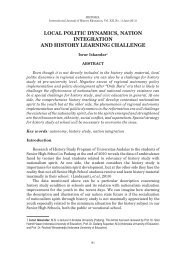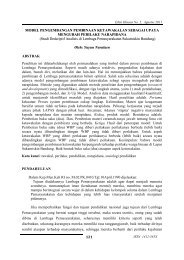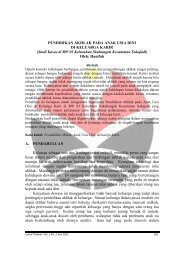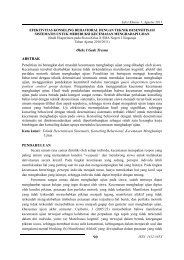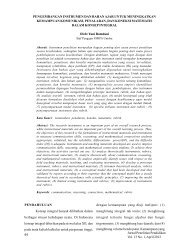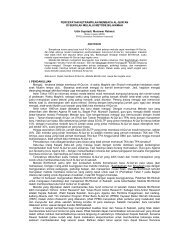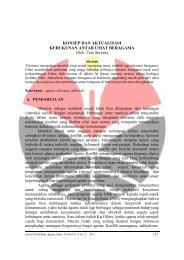a descriptive study on the teacher talk at eyl classroom - Jurnal UPI
a descriptive study on the teacher talk at eyl classroom - Jurnal UPI
a descriptive study on the teacher talk at eyl classroom - Jurnal UPI
Create successful ePaper yourself
Turn your PDF publications into a flip-book with our unique Google optimized e-Paper software.
CONAPLIN JOURNAL<br />
Ind<strong>on</strong>esian Journal of Applied Linguistics, Vol. 1 No. 2 (January 2012)<br />
@The Author(s) 2012<br />
A DESCRIPTIVE STUDY ON THE TEACHER TALK AT EYL<br />
CLASSROOM<br />
Liani Setiaw<strong>at</strong>i<br />
SMPK 1 BPK Penabur Bandung<br />
email: liani_stwt@yahoo.co.uk<br />
Abstract: The use of c<strong>on</strong>structive <strong>teacher</strong> <strong>talk</strong> (TT) is very important and effective in<br />
scaffolding young learners to improve <strong>the</strong>ir skill in target language. Never<strong>the</strong>less, <strong>the</strong>re is<br />
an argument th<strong>at</strong> too much <strong>teacher</strong> <strong>talk</strong> can even decrease students‟ motiv<strong>at</strong>i<strong>on</strong>. The<br />
present <str<strong>on</strong>g>study</str<strong>on</strong>g> tries to reveal <strong>the</strong> suitable amount and <strong>the</strong> students‟ percepti<strong>on</strong> of <strong>teacher</strong><br />
<strong>talk</strong>. Apart from th<strong>at</strong>, <strong>the</strong>re is an <strong>at</strong>tempt to find out <strong>the</strong> fe<strong>at</strong>ures of <strong>teacher</strong> <strong>talk</strong>, <strong>the</strong><br />
frequency of ei<strong>the</strong>r display and referential questi<strong>on</strong>s or <strong>teacher</strong>s‟ assessments and ways in<br />
giving feedback. This <str<strong>on</strong>g>descriptive</str<strong>on</strong>g> <str<strong>on</strong>g>study</str<strong>on</strong>g> is c<strong>on</strong>ducted to find out how <strong>teacher</strong>s make use of<br />
<strong>the</strong>ir <strong>teacher</strong> <strong>talk</strong> n<strong>at</strong>urally in <strong>classroom</strong> settings. To gain deeper insight and<br />
understanding, both qualit<strong>at</strong>ive and quantit<strong>at</strong>ive research design were employed. The<br />
qualit<strong>at</strong>ive d<strong>at</strong>a were obtained through direct observ<strong>at</strong>i<strong>on</strong> and <strong>teacher</strong>s – students‟<br />
interview. Moreover, <strong>the</strong> <strong>teacher</strong>s – students‟ questi<strong>on</strong>naire, video recording and field<br />
notes also added significant value towards <strong>the</strong> findings of this <str<strong>on</strong>g>study</str<strong>on</strong>g>. Quantit<strong>at</strong>ive d<strong>at</strong>a, <strong>on</strong><br />
<strong>the</strong> o<strong>the</strong>r hand, were gained from <strong>the</strong> calcul<strong>at</strong>i<strong>on</strong> of students‟ questi<strong>on</strong>naire scores which<br />
are represented in percentage. Both qualit<strong>at</strong>ive and quantit<strong>at</strong>ive d<strong>at</strong>a were coded,<br />
c<strong>at</strong>egorized, interpreted, <str<strong>on</strong>g>descriptive</str<strong>on</strong>g>ly described and finally displayed in <strong>the</strong> form of<br />
tables. The research findings show th<strong>at</strong> despite <strong>the</strong> <strong>teacher</strong> <strong>talk</strong>‟s capability to be good<br />
model for young learners, most students found <strong>the</strong> class more motiv<strong>at</strong>ing, interesting, and<br />
challenging when <strong>the</strong> <strong>teacher</strong>s minimized <strong>the</strong>ir <strong>teacher</strong> <strong>talk</strong> and made use not <strong>on</strong>ly more<br />
c<strong>on</strong>structive <strong>teacher</strong> <strong>talk</strong> but also interesting activities. In c<strong>on</strong>clusi<strong>on</strong>, since <strong>teacher</strong> <strong>talk</strong><br />
serves not <strong>on</strong>ly as a medium to achieve young learners‟s learning objectives but also as a<br />
tool to build better dynamic interacti<strong>on</strong> between <strong>teacher</strong> and students in <strong>classroom</strong><br />
settings, it is advisable for all EFL <strong>teacher</strong>s to improve <strong>the</strong>ir effective c<strong>on</strong>structive <strong>talk</strong><br />
towards <strong>the</strong>ir students.<br />
Key words: SLA, TT (Teacher Talk), TTT (Teacher Talk Time), discourse Analysis,<br />
code switching, c<strong>on</strong>vers<strong>at</strong>i<strong>on</strong>al analysis, ST (Students Talk) , STT (Student Talk Time)<br />
Abstrak: Penggunaan tuturan guru yang k<strong>on</strong>struktif sang<strong>at</strong>lah penting dan efektif dalam<br />
memasilitasi pemelajar usia dini untuk meningk<strong>at</strong>kan keterampilan mereka dalam bahasa<br />
target. Namun, ada pendap<strong>at</strong> bahwa terlalu banyak ujaran yang dikemukakan guru dap<strong>at</strong><br />
menurunkan motivasi pemelajar. Studi ini berupaya untuk mengungkap jumlah tuturan<br />
yang sesuai dan persepsi pemelajar akan tuturan guru. Selain itu, upaya juga dilakukan<br />
untuk mencari ciri-ciri tuturan guru, frekuensi pertanyaan pemajanan dan referensial <strong>at</strong>au<br />
penugasan dan cara dalam memberikan timbal balik. Studi deskriptif ini dilaksanakan<br />
untuk mengetahui bagaimana guru memanfa<strong>at</strong>kan tuturannya secara n<strong>at</strong>ural didalam<br />
seting kelas. Untuk mendap<strong>at</strong>kan pemahaman yang lebih mendalam, studi ini<br />
menggunakan disain kuantit<strong>at</strong>if dan kualit<strong>at</strong>if. D<strong>at</strong>a kualit<strong>at</strong>if didap<strong>at</strong>kan melalui<br />
observasi langsung dan wawancara antara guru dan pemelajar. Lebih lanjut lagi,<br />
kuesi<strong>on</strong>er, rekaman video dan c<strong>at</strong><strong>at</strong>an lapangan yang digunakan juga menjadi nilai tambah<br />
bagi temuan studi ini. Disisi lain, d<strong>at</strong>a kuantit<strong>at</strong>if diperoleh dari penghitungan skor<br />
33 | P a g e
Liani Setiaw<strong>at</strong>i<br />
A Descriptive Study <strong>on</strong> <strong>the</strong> Teacher Talk <strong>at</strong> EYL Classroom<br />
kuesi<strong>on</strong>er pemelajar yang direpresentasikan dalam persentase. D<strong>at</strong>a kualit<strong>at</strong>if dan<br />
kuantit<strong>at</strong>if dikodekan, dik<strong>at</strong>egorisasikan, diintepretasikan, dijelaskan secara deskriptif dan<br />
digambarkan dalam bentuk tabel. Temuan studi ini mengungkapkan bahwa walaupun<br />
tuturan yang dikemukakan guru merupakan model yang bagus bagi pemelajar usia dini,<br />
kebanyakan pemelajar menganggap bahwa kelas lebih memotivasi, menarik, dan<br />
menantang ketika guru meminimalisir tuturannya dan tidak hanya menggunakan tuturan<br />
yang k<strong>on</strong>struktif tetapi juga aktivitas kelas yang menarik. Kesimpulannya, karena ujaran<br />
guru tidak hanya berfungsi sebagai sebuah media tetapi juga sebagai al<strong>at</strong> untuk<br />
membangun interaksi dan dinamika yang lebih baik antara guru dan pemelajar dalam<br />
seting kelas, disarankan bagi semua guru Bahasa Inggris sebagai bahasa asing untuk<br />
meningk<strong>at</strong>kan kemampuan bertutur <strong>at</strong>au berbicara secara k<strong>on</strong>struktif mereka pada<br />
pemelajar.<br />
K<strong>at</strong>a kunci: SLA, ujaran guru, waktu ujaran guru, analisis wacana, alih kode, analisis<br />
percakapan, ujaran pemelajar, waktu ujaran pemelajar.<br />
Teaching young children is very much different from teaching adults in a way th<strong>at</strong> <strong>the</strong>y are<br />
often more enthusiastic, lively learners, and learn <strong>the</strong> target language faster than adults. These<br />
require experienced <strong>teacher</strong>s to be able to find ways to c<strong>on</strong>struct successful less<strong>on</strong>s and<br />
activities which place pupils <strong>at</strong> <strong>the</strong> very heart of teaching and learning. Language becomes<br />
essential in providing young learners with a new tool, opens up new opportunities for doing<br />
things and for organizing inform<strong>at</strong>i<strong>on</strong> through <strong>the</strong> use of words and symbols. It is clear th<strong>at</strong><br />
c<strong>on</strong>structive <strong>talk</strong> is <strong>on</strong>e of <strong>the</strong> most essential ingredients of a good less<strong>on</strong>, a vital part to<br />
engage any student in <strong>the</strong>ir learning, an instrument to transform rel<strong>at</strong>i<strong>on</strong>ships (Coultas, 2009<br />
p.1).<br />
However, less<strong>on</strong>s th<strong>at</strong> encourage and organize pupils to <strong>talk</strong> about <strong>the</strong>ir learning are not easy<br />
to teach. Thus, <strong>teacher</strong>s should functi<strong>on</strong> <strong>the</strong>ir <strong>talk</strong> as „central point‟ to gain effective teaching<br />
and learning process (Vygotsky, 1978). Wood as cited in Camer<strong>on</strong> (2001 pp. 8-9) makes<br />
clearer th<strong>at</strong> <strong>teacher</strong>s‟ <strong>talk</strong> is very effective in scaffolding young learners in various ways, thus<br />
<strong>the</strong>y have to manage <strong>the</strong>ir <strong>talk</strong> to become meaningful, encouraging and use a lot of repetiti<strong>on</strong>s<br />
<strong>on</strong> key language in order to make young learners be able to improve <strong>the</strong>ir skills in <strong>the</strong> target<br />
language (McNaught<strong>on</strong>, 2002). Nunan streng<strong>the</strong>ns th<strong>at</strong> <strong>teacher</strong>s always modify <strong>the</strong> language<br />
<strong>the</strong>y use to make it easier to comprehend. This, in turn, helps <strong>the</strong> learner to acquire <strong>the</strong> target<br />
language (1989 p. 25).<br />
Acknowledging its importance, many research have been c<strong>on</strong>ducted <strong>on</strong> TT. TT makes up<br />
around 70% of <strong>classroom</strong> language (Cook, 2000; Chaudr<strong>on</strong>, 1998. Xiao-Hui (2010) analyzing<br />
Teacher Talk <strong>on</strong> <strong>the</strong> basis of Relevance Theory was able to prove th<strong>at</strong> TT – used in relevance -<br />
will be a decisive factor of students‟ success or failure in <strong>classroom</strong> teaching. Meanwhile,<br />
Price (2003) investig<strong>at</strong>ed <strong>the</strong> amount of TT and suggested th<strong>at</strong> <strong>teacher</strong>s should c<strong>on</strong>tinue<br />
developing an awareness of <strong>the</strong>ir teaching practice and ways to avoid „needless or overlengthy<br />
explan<strong>at</strong>i<strong>on</strong>s and instructi<strong>on</strong>s (Richards and Lockhart, 1996 p.114) or refine <strong>the</strong>ir<br />
questi<strong>on</strong>ing and explan<strong>at</strong>i<strong>on</strong>s methods. In line with this, Nunan (1991 p. 198) st<strong>at</strong>es th<strong>at</strong><br />
research … shows th<strong>at</strong> <strong>teacher</strong>s need to pay <strong>at</strong>tenti<strong>on</strong> to <strong>the</strong> amount and type of <strong>talk</strong>ing <strong>the</strong>y<br />
do, and to evalu<strong>at</strong>e its effectiveness in <strong>the</strong> light of <strong>the</strong>ir pedagogical objectives.<br />
34
CONAPLIN JOURNAL<br />
Ind<strong>on</strong>esian Journal of Applied Linguistics, Vol. 1 No. 2 (January 2012)<br />
@The Author(s) 2012<br />
Never<strong>the</strong>less, <strong>the</strong> findings obtained so far haven‟t really revealed <strong>the</strong> phenomena of <strong>the</strong><br />
importance and effectiveness of <strong>teacher</strong> <strong>talk</strong>. Thus, this <str<strong>on</strong>g>study</str<strong>on</strong>g> <strong>at</strong>tempts to answer <strong>the</strong><br />
following questi<strong>on</strong>s: (1) Wh<strong>at</strong> is <strong>the</strong> amount of TTT ( <strong>teacher</strong> Talk Time) used by <strong>the</strong> <strong>teacher</strong>s<br />
in <strong>classroom</strong> settings?, (2) Wh<strong>at</strong> is <strong>the</strong> students‟ percepti<strong>on</strong> towards <strong>the</strong> amount of TTT<br />
(Teacher Talk Time) used by EFL <strong>teacher</strong>s in <strong>the</strong> process of teaching and learning?, (3) Wh<strong>at</strong><br />
are <strong>the</strong> TT ( Teacher Talk) fe<strong>at</strong>ures comm<strong>on</strong>ly used by EFL <strong>teacher</strong>s in <strong>the</strong> process of teaching<br />
and learning?, (4) Wh<strong>at</strong>‟s <strong>the</strong> frequency of display questi<strong>on</strong>s and referential questi<strong>on</strong>s used by<br />
<strong>teacher</strong>s in <strong>classroom</strong> activity?, and (5) Wh<strong>at</strong>‟s <strong>the</strong> frequency of different types of <strong>teacher</strong>‟s<br />
assessment? In wh<strong>at</strong> ways will <strong>teacher</strong>s give feedback to students when <strong>the</strong> errors occur during<br />
<strong>the</strong> teaching-learning process? Some fundamental <strong>the</strong>ories are taken as <strong>the</strong> basic of this <str<strong>on</strong>g>study</str<strong>on</strong>g>.<br />
The Role of TT in Foreign Language Learning<br />
„If <strong>the</strong> sec<strong>on</strong>d language is learnt as a foreign language in a language class in a n<strong>on</strong>-supportive<br />
envir<strong>on</strong>ment, like in Ind<strong>on</strong>esia , instructi<strong>on</strong> (<strong>teacher</strong> <strong>talk</strong>) is likely to be <strong>the</strong> major or even <strong>the</strong><br />
<strong>on</strong>ly source of target language input‟ (Stern, 1983 p. 400). Krashen with his SLA <strong>the</strong>ory says<br />
TT determines successful language learning by providing plenty of and high quality input for<br />
(1985 p. 78). Nunan (1991) also points out: Teacher <strong>talk</strong> is a crucial of importance, not <strong>on</strong>ly<br />
for <strong>the</strong> organiz<strong>at</strong>i<strong>on</strong> of <strong>the</strong> <strong>classroom</strong> but also for <strong>the</strong> process of acquisiti<strong>on</strong>. It is through<br />
language th<strong>at</strong> <strong>teacher</strong>s ei<strong>the</strong>r succeed or fail in implementing <strong>the</strong>ir plans. In terms of<br />
acquisiti<strong>on</strong>, <strong>teacher</strong> <strong>talk</strong> is important because it is probably <strong>the</strong> major source of<br />
comprehensible target language input <strong>the</strong> learner is likely to receive.<br />
Yet, to determine wh<strong>at</strong> <strong>the</strong> best and <strong>the</strong> most effective <strong>teacher</strong> <strong>talk</strong> is like is not easy since<br />
every <strong>teacher</strong> brings <strong>the</strong>ir certain characteristics which are influenced by different age, sex,<br />
previous educ<strong>at</strong>i<strong>on</strong>, and pers<strong>on</strong>al qualities. Above all, <strong>teacher</strong>s also bring <strong>the</strong>ir language<br />
background and experience, professi<strong>on</strong>al training as a linguist and <strong>teacher</strong>, previous language<br />
teaching experience, and more or less formul<strong>at</strong>ed <strong>the</strong>oretical presuppositi<strong>on</strong>s about language,<br />
language learning and teaching‟ (Stern, 1983 p. 500).<br />
L<strong>on</strong>g and S<strong>at</strong>o (1983) observed all kinds of phenomena about <strong>teacher</strong> <strong>talk</strong>, and made some<br />
comparis<strong>on</strong>s between <strong>the</strong> language <strong>teacher</strong>s use in and out of language <strong>classroom</strong>s. Their main<br />
findings are as follows:<br />
1. Formal adjustments occur <strong>at</strong> all language levels – in pr<strong>on</strong>unci<strong>at</strong>i<strong>on</strong>, lexis and grammar.<br />
2. In general, ungramm<strong>at</strong>ical speech modific<strong>at</strong>i<strong>on</strong>s do not occur.<br />
3. Interacti<strong>on</strong>al adjustments occur. (Ellis, 1985 p. 145)<br />
Besides, <strong>teacher</strong> <strong>talk</strong> is simplified in o<strong>the</strong>r ways – syntactically, ph<strong>on</strong>ologically and<br />
semantically. Chaudr<strong>on</strong> (1988 p. 85), proposed <strong>teacher</strong> <strong>talk</strong> in language <strong>classroom</strong>s with his<br />
seven modific<strong>at</strong>i<strong>on</strong>s: 1) R<strong>at</strong>e of speech appears to be slower; 2) Pauses, which may be<br />
evidence of <strong>the</strong> speaker planning more, are possibly more frequent and l<strong>on</strong>ger; 3)<br />
Pr<strong>on</strong>unci<strong>at</strong>i<strong>on</strong> tends to be exagger<strong>at</strong>ed and simplified ; 4)Vocabulary use is more basic; 5)<br />
Degree of subordin<strong>at</strong>i<strong>on</strong> is slower ; 6) More declar<strong>at</strong>ives and st<strong>at</strong>ements are used than<br />
questi<strong>on</strong>s; 7)Teachers may self-repe<strong>at</strong> more frequently.<br />
35 | P a g e
Liani Setiaw<strong>at</strong>i<br />
A Descriptive Study <strong>on</strong> <strong>the</strong> Teacher Talk <strong>at</strong> EYL Classroom<br />
The important issue is whe<strong>the</strong>r <strong>the</strong> amount of <strong>teacher</strong> <strong>talk</strong> influences learners‟ L2 acquisiti<strong>on</strong><br />
of foreign language learning. Many researche have proved th<strong>at</strong> th<strong>at</strong> <strong>teacher</strong>s tend to do most of<br />
<strong>the</strong> <strong>classroom</strong> <strong>talk</strong>- over 70% of <strong>the</strong> total <strong>talk</strong>. (Cook, 2000; Chaudr<strong>on</strong>, 1998). When TT<br />
domin<strong>at</strong>es <strong>the</strong> <strong>classroom</strong>, ST will be indeed severely restricted, allowing <strong>the</strong>m <strong>on</strong>ly little<br />
opportunity to develop <strong>the</strong>ir language proficiency. In order to avoid <strong>the</strong> overuse of TT,<br />
<strong>teacher</strong>s have to maximize STT and minimize TTT. Harmer points out th<strong>at</strong> <strong>the</strong> best less<strong>on</strong>s are<br />
<strong>on</strong>es where STT is maximized. Getting students to speak – to use <strong>the</strong> language <strong>the</strong>y are<br />
learning – is a vital part of a <strong>teacher</strong>‟s job (Harmer, 2000 p. 4).<br />
However, American scholar W<strong>on</strong>g Fillmore found out th<strong>at</strong> success in SLA occurred in<br />
<strong>teacher</strong>-domin<strong>at</strong>ed class. There are times th<strong>at</strong> in <strong>classroom</strong> in which <strong>the</strong> <strong>teacher</strong> can serve as<br />
<strong>the</strong> main source of input, <strong>the</strong> learners can receive enough and accur<strong>at</strong>e input. Thus, Fillmore<br />
argued <strong>the</strong> amount of TT should not be decreased blindly.<br />
Teachers’ Questi<strong>on</strong>s<br />
Questi<strong>on</strong>ing is <strong>on</strong>e of <strong>the</strong> most comm<strong>on</strong> techniques used by <strong>teacher</strong>s (Richards & Lockhart,<br />
2000) and serves as <strong>the</strong> principal way in which <strong>teacher</strong>s c<strong>on</strong>trol <strong>the</strong> <strong>classroom</strong> interacti<strong>on</strong>s.<br />
The tendency for <strong>teacher</strong>s to ask many questi<strong>on</strong>s has been observed in many investig<strong>at</strong>i<strong>on</strong>s<br />
(Chaudr<strong>on</strong>, 1988). In some <strong>classroom</strong>s, over half of class time is taken up by questi<strong>on</strong> and<br />
answer exchanges (Richards & Lockhart, 2000).<br />
The pervasiveness of <strong>teacher</strong> questi<strong>on</strong>s in <strong>the</strong> <strong>classroom</strong> can be explained by <strong>the</strong> specific<br />
functi<strong>on</strong>s <strong>the</strong>y perform. These functi<strong>on</strong>s can be grouped into three broad areas (D<strong>on</strong>ald &<br />
Eggen, 1989):<br />
1. diagnostic: allow <strong>teacher</strong>s to glimpse into <strong>the</strong> minds of students to find out not <strong>on</strong>ly wh<strong>at</strong><br />
<strong>the</strong>y know or d<strong>on</strong>‟t know but also how <strong>the</strong>y think about a topic.<br />
2. instructi<strong>on</strong>al: questi<strong>on</strong>s provide students learn new m<strong>at</strong>erial and integr<strong>at</strong>e it with <strong>the</strong> old<br />
<strong>on</strong>e, provide <strong>the</strong> practice and feedback essential for <strong>the</strong> development<br />
3. motiv<strong>at</strong>i<strong>on</strong>al : allow <strong>teacher</strong>s to engage with students actively in <strong>the</strong> less<strong>on</strong> <strong>at</strong> hand,<br />
challenging <strong>the</strong>ir thinking and posing problems for <strong>the</strong>m to c<strong>on</strong>sider.<br />
Barnes (1969) examined <strong>the</strong> questi<strong>on</strong>s asked by <strong>teacher</strong>s and classified <strong>the</strong>m into four types:<br />
„Wh<strong>at</strong>‟ questi<strong>on</strong>s, „How‟ and „Why‟ questi<strong>on</strong> – open and closed questi<strong>on</strong>s. Meanwhile,<br />
Richards & Lockhart (2000) classify <strong>the</strong> questi<strong>on</strong>s into three c<strong>at</strong>egories in terms of <strong>the</strong> purpose<br />
of questi<strong>on</strong>s in <strong>classroom</strong> – procedural, c<strong>on</strong>vergent, and divergent. Procedural questi<strong>on</strong>s have<br />
to do with <strong>classroom</strong> procedures and routines and <strong>classroom</strong> management. C<strong>on</strong>vergent and<br />
divergent questi<strong>on</strong>s are designed to engage students in <strong>the</strong> c<strong>on</strong>tent of less<strong>on</strong>, to facilit<strong>at</strong>e<br />
comprehensi<strong>on</strong>, and to promote <strong>classroom</strong> interacti<strong>on</strong>. C<strong>on</strong>vergent questi<strong>on</strong>s encourage<br />
similar student resp<strong>on</strong>ses, or resp<strong>on</strong>ses which focus <strong>on</strong> a central <strong>the</strong>me, such as „short<br />
answers‟ - „yes‟ or „no‟ or „short st<strong>at</strong>ements‟. They do not require students to engage in highlevel<br />
thinking. On <strong>the</strong> c<strong>on</strong>trary, divergent questi<strong>on</strong>s encourage diverse student resp<strong>on</strong>ses<br />
which require higher-level thinking.<br />
However, <strong>the</strong> questi<strong>on</strong> types used in this <str<strong>on</strong>g>study</str<strong>on</strong>g> is <strong>on</strong>e proposed by L<strong>on</strong>g and S<strong>at</strong>o (1983),<br />
„display‟ and „referential‟ questi<strong>on</strong>s. Display questi<strong>on</strong>s used when <strong>teacher</strong>s know <strong>the</strong> answers<br />
and designed to elicit or display particular structures. For example, „wh<strong>at</strong>’s <strong>the</strong> opposite of up<br />
36
CONAPLIN JOURNAL<br />
Ind<strong>on</strong>esian Journal of Applied Linguistics, Vol. 1 No. 2 (January 2012)<br />
@The Author(s) 2012<br />
in English?’ . Referential questi<strong>on</strong>s, though, refer to <strong>the</strong> questi<strong>on</strong>s th<strong>at</strong> <strong>teacher</strong>s do not know<br />
<strong>the</strong> answers to, and can gain various subjective inform<strong>at</strong>i<strong>on</strong>. For example, „Why d<strong>on</strong>’t you do<br />
your homework?’ Closed questi<strong>on</strong>s and c<strong>on</strong>vergent questi<strong>on</strong>s have <strong>the</strong> same fe<strong>at</strong>ure as<br />
referential questi<strong>on</strong>s, so are open questi<strong>on</strong>s and divergent questi<strong>on</strong>s. Research results proved<br />
th<strong>at</strong> <strong>teacher</strong>s tend to ask more display questi<strong>on</strong>s than referential questi<strong>on</strong>s (L<strong>on</strong>g & S<strong>at</strong>o, 1983;<br />
Pica & L<strong>on</strong>g, cited from Ellis, 1994).<br />
Ei<strong>the</strong>r positive or neg<strong>at</strong>ive feedback is <strong>teacher</strong>s‟ evalu<strong>at</strong>i<strong>on</strong> of <strong>the</strong> student resp<strong>on</strong>se (Cook,<br />
2000), given by means of praise, by any relevant comment or acti<strong>on</strong>, or by silence (Richards,<br />
& Lockhart, 2000). Weinstein (1989) found th<strong>at</strong> children learned how „smart‟ <strong>the</strong>y were<br />
mainly from <strong>teacher</strong>s‟ feedback in <strong>the</strong> form of marks, comments, and <strong>the</strong> degree and type of<br />
praise and criticism. (Wheldal and Merrett, 1987) cite a large number of studies showing th<strong>at</strong><br />
rewards such as praise, are far more effective than punishment. Within this situ<strong>at</strong>i<strong>on</strong>, learners<br />
begin to develop <strong>the</strong>ir „Positive Thinking‟, which <strong>the</strong>y claim to be highly effective (Wheldal<br />
and Merrett, 1984). Feedback has two main distinguishable comp<strong>on</strong>ents: Correcti<strong>on</strong> and<br />
Assessment (Ur, 2000 p. 242).<br />
Since learners will inevitably make mistakes in <strong>the</strong> process of learning, Brown (2002 p. 205)<br />
says th<strong>at</strong> “ A learner‟s errors … are significant in (th<strong>at</strong>) <strong>the</strong>y provide to <strong>the</strong> researcher<br />
evidence of how language is learned or acquired, wh<strong>at</strong> str<strong>at</strong>egies or procedures <strong>the</strong> learner is<br />
employing in <strong>the</strong> discovery of <strong>the</strong> language.” “ It is a vital part of <strong>the</strong> <strong>teacher</strong>‟s role to point<br />
out students‟ mistakes and provide correcti<strong>on</strong>. In correcti<strong>on</strong>, some specific inform<strong>at</strong>i<strong>on</strong> is<br />
provided <strong>on</strong> aspects of <strong>the</strong> <strong>teacher</strong>‟s performance, through explan<strong>at</strong>i<strong>on</strong>, or provisi<strong>on</strong> of better<br />
or o<strong>the</strong>r altern<strong>at</strong>ives, or through elicit<strong>at</strong>i<strong>on</strong> of <strong>the</strong>se from <strong>the</strong> learner (Ur, 2000). Correcti<strong>on</strong><br />
helps students to clarify <strong>the</strong>ir understanding of meaning and c<strong>on</strong>structi<strong>on</strong> of language.<br />
Basically, it is worth praising learners for <strong>the</strong>ir success and correct <strong>the</strong>m when <strong>the</strong>y fail.<br />
Praising expressi<strong>on</strong>s which use encouraging words and noises („good‟, „well-d<strong>on</strong>e‟,<br />
„fantastic‟, „mmm‟, etc) when learners are doing well (Harmer, 2000).<br />
Assessment refers to <strong>the</strong> tools, techniques and procedures for collecting and interpreting<br />
inform<strong>at</strong>i<strong>on</strong> about wh<strong>at</strong> learners can and cannot do. In assessment, learners are simply<br />
informed how well or badly he or she has performed. Comments such as „Excellent‟ and „Very<br />
good‟ are comm<strong>on</strong>s <strong>at</strong> <strong>the</strong> end of a written assignment (Ur, 2000). One vital part is th<strong>at</strong><br />
<strong>teacher</strong>s must not forget th<strong>at</strong> assessment is given with <strong>on</strong>e purpose, th<strong>at</strong> is to help and promote<br />
EFL learning. Therefore, <strong>teacher</strong>‟s <strong>talk</strong> should be full of approval and encouragement besides<br />
c<strong>on</strong>firm<strong>at</strong>i<strong>on</strong> (Xiaoyan, 2006).<br />
METHODOLOGY<br />
This <str<strong>on</strong>g>descriptive</str<strong>on</strong>g> <str<strong>on</strong>g>study</str<strong>on</strong>g> employs both quantit<strong>at</strong>ive and qualit<strong>at</strong>ive designs in order to find<br />
deeper knowledge and understanding of <strong>teacher</strong> <strong>talk</strong> used by EYL <strong>teacher</strong>s <strong>at</strong> <strong>the</strong> fourth grade<br />
of <strong>on</strong>e Intern<strong>at</strong>i<strong>on</strong>al Elementary School in Bandung. Thus, <strong>the</strong> participants were <strong>the</strong> 3<br />
English n<strong>at</strong>ive speakers and 18 students <strong>the</strong>re.<br />
37 | P a g e
Liani Setiaw<strong>at</strong>i<br />
A Descriptive Study <strong>on</strong> <strong>the</strong> Teacher Talk <strong>at</strong> EYL Classroom<br />
The qualit<strong>at</strong>ive d<strong>at</strong>a were taken from <strong>teacher</strong>s and students‟ questi<strong>on</strong>naire and interview.<br />
Besides, <strong>the</strong> Teacher Observ<strong>at</strong>i<strong>on</strong> Sheet, field notes, <strong>classroom</strong> observ<strong>at</strong>i<strong>on</strong>s, audio and video<br />
recording were also utilized. The quantit<strong>at</strong>ive d<strong>at</strong>a were taken from <strong>the</strong> questi<strong>on</strong>naire scores<br />
presented in <strong>the</strong> percentage. All d<strong>at</strong>a were calcul<strong>at</strong>ed, coded, c<strong>at</strong>egorized, transcribed,<br />
interpreted, described, and presented in <strong>the</strong> forms of tables and graphs.<br />
To analyze <strong>the</strong> d<strong>at</strong>a from <strong>the</strong> questi<strong>on</strong>naire, <strong>the</strong> researcher designed a students‟ questi<strong>on</strong>naire<br />
adapted from Richards & Lockhart (1994 p. 20) (see appendix) to collect inform<strong>at</strong>i<strong>on</strong> <strong>on</strong><br />
language students‟ assessment about <strong>the</strong>ir English classes and <strong>the</strong>ir <strong>teacher</strong>s‟ speech <strong>on</strong> <strong>the</strong><br />
basis of <strong>the</strong>ir usual, normal activities. As for <strong>teacher</strong>s‟ questi<strong>on</strong>naire, Likert Scale (str<strong>on</strong>gly<br />
agree, agree, …… str<strong>on</strong>gly disagree) will be used. All answers of all items <strong>on</strong> <strong>the</strong><br />
questi<strong>on</strong>naire checked and recapitul<strong>at</strong>ed based <strong>on</strong> <strong>the</strong> <strong>teacher</strong> and <strong>the</strong> students‟ resp<strong>on</strong>ses.<br />
Then, <strong>the</strong> scores are calcul<strong>at</strong>ed and summed up.<br />
FINDINGS AND DISCUSSION<br />
The Participants D<strong>at</strong>a<br />
Teachers' Age<br />
20 - 30<br />
30 - 40<br />
Teachers'<br />
Educ<strong>at</strong>i<strong>on</strong>al …<br />
English<br />
From <strong>the</strong> d<strong>at</strong>a collected, it is revealed th<strong>at</strong> 2 of three participants age (67%) are between 20 –<br />
30 years old and <strong>on</strong>ly <strong>on</strong>e participant whose age is above 30. The d<strong>at</strong>a result also shows th<strong>at</strong> 2<br />
of <strong>the</strong> participants, th<strong>at</strong> is 67%, gradu<strong>at</strong>ed from English department in England universities.<br />
One participant gradu<strong>at</strong>ed from engineering faculty in Australia.<br />
Target Language Observ<strong>at</strong>i<strong>on</strong> Scheme of <strong>the</strong> Participants<br />
During <strong>the</strong> class observ<strong>at</strong>i<strong>on</strong>, <strong>the</strong> researcher observed <strong>the</strong> <strong>teacher</strong>s‟ performance and complete<br />
<strong>the</strong> c<strong>at</strong>egories listed in <strong>the</strong> Target Language Observ<strong>at</strong>i<strong>on</strong> Scheme (see <strong>the</strong> appendix) , <strong>the</strong>n <strong>the</strong><br />
results were c<strong>at</strong>egorized and interpreted before <strong>the</strong>y were displayed in a result table, shown in<br />
<strong>the</strong> percentage .<br />
Note: 0 = extremely low ; 1 = low ; 2 = fair ; 3 = high ; 4 = extremely high<br />
38
CONAPLIN JOURNAL<br />
Ind<strong>on</strong>esian Journal of Applied Linguistics, Vol. 1 No. 2 (January 2012)<br />
@The Author(s) 2012<br />
Table 1 - Target Language Observ<strong>at</strong>i<strong>on</strong> Scheme of <strong>the</strong> Participants (In Percentage)<br />
Descripti<strong>on</strong> 0 1 2 3 4<br />
01. Use of language 1 100<br />
02. Use of language 2 0<br />
03. Teacher Talk Time 33 67<br />
04. Explicit less<strong>on</strong> structure 33 67<br />
05. Task orient<strong>at</strong>i<strong>on</strong> 100<br />
06. Clarity 33 67<br />
07. Initi<strong>at</strong>e problem solving 33 67<br />
08. Pers<strong>on</strong>alized questi<strong>on</strong>s and comments 0<br />
09. Positive reinforcement 100<br />
10. Neg<strong>at</strong>ive reinforcement 33 67<br />
11. Correcti<strong>on</strong>s 33 67<br />
12. Pacing 67 33<br />
13. Use of audio-visual aids 100<br />
14. Gestures 33 67<br />
15. Humour 33 67<br />
16. Enthusiasm 50 50<br />
The table above shows th<strong>at</strong> most of <strong>the</strong> <strong>teacher</strong>s use English 100% since <strong>the</strong>y are real n<strong>at</strong>ive<br />
speakers, which encourages students to <strong>talk</strong> in <strong>the</strong> target language. The use of sec<strong>on</strong>d<br />
language, th<strong>at</strong> is Ind<strong>on</strong>esian, for those three n<strong>at</strong>ive speakers, is null percent since <strong>the</strong>y are not<br />
allowed to <strong>talk</strong> in Ind<strong>on</strong>esian within <strong>the</strong> school envir<strong>on</strong>ment. This situ<strong>at</strong>i<strong>on</strong> is very beneficial<br />
for young learners to acquire <strong>the</strong> target language autom<strong>at</strong>ically because <strong>the</strong>y use and are faced<br />
to <strong>the</strong> target language most of <strong>the</strong> time. The use of audio-visual is very high too, th<strong>at</strong> is 100%.<br />
This shows th<strong>at</strong> <strong>the</strong> three <strong>teacher</strong>s have already been able to make use of <strong>the</strong> technology skills.<br />
Gestures and humour are also employed in class to support <strong>the</strong> teaching-learning situ<strong>at</strong>i<strong>on</strong><br />
(67%). Most of <strong>the</strong> TTT used in class is so high. This is in line with Ellis (1985 p. 43) saying<br />
th<strong>at</strong> successful outcomes may depend <strong>on</strong> <strong>the</strong> type of language used by <strong>the</strong> <strong>teacher</strong> and <strong>the</strong> type<br />
of interacti<strong>on</strong>s occurring in <strong>classroom</strong>. Specifically for Ind<strong>on</strong>esian young learners, where <strong>the</strong><br />
circumstance outside <strong>the</strong> class doesn‟t support <strong>the</strong>m to use <strong>the</strong> target language in daily<br />
c<strong>on</strong>vers<strong>at</strong>i<strong>on</strong>, class becomes an ideal place for <strong>the</strong>m to learn English since it allows <strong>the</strong>m to be<br />
in c<strong>on</strong>tinuous c<strong>on</strong>tact with <strong>the</strong> <strong>teacher</strong>s who speak in <strong>the</strong> target language, <strong>the</strong>refore TT should<br />
be employed very high. 67% (2 <strong>teacher</strong>s) also taught giving explicit less<strong>on</strong> structure, but <strong>on</strong>e<br />
<strong>teacher</strong> (33%), I noticed – failed since she lacked <strong>the</strong> ability for c<strong>on</strong>trolling <strong>the</strong> class. One<br />
<strong>teacher</strong> was very unclear, again, because she couldn‟t c<strong>on</strong>trol <strong>the</strong> class well. Her class was so<br />
noisy and <strong>the</strong> students <strong>talk</strong>ed by <strong>the</strong>mselves, ignored her instructi<strong>on</strong>s and gave not rel<strong>at</strong>ed<br />
comments. Doe to <strong>the</strong> positive reinforcement, <strong>the</strong> 3 <strong>teacher</strong>s (100%) got extremely high point<br />
– 4. It shows to us th<strong>at</strong> <strong>the</strong>y have already understood <strong>the</strong> importance of positive reinforcement<br />
to build up <strong>the</strong>ir learning motiv<strong>at</strong>i<strong>on</strong>. And 2 <strong>teacher</strong>s (67%) were successful to avoid using<br />
neg<strong>at</strong>ive reinforcement, while <strong>on</strong>e <strong>teacher</strong> (33%) failed avoiding using it since she thre<strong>at</strong>ened<br />
<strong>the</strong> class so many times when <strong>the</strong> students disobeyed her.<br />
39 | P a g e
Liani Setiaw<strong>at</strong>i<br />
A Descriptive Study <strong>on</strong> <strong>the</strong> Teacher Talk <strong>at</strong> EYL Classroom<br />
Teacher Talk Time<br />
Table 2 - The Results of <strong>the</strong> questi<strong>on</strong>naire about TTT (Teacher Talk Time)<br />
Appropri<strong>at</strong>e - t Less than 20 20 – 25 25 – 30 30 – 35<br />
(min)<br />
Students Number 12 ------ 6 -------<br />
Percentage 67% ------- 33% -------<br />
From <strong>the</strong> raw and percentage results of questi<strong>on</strong>naire, we can see th<strong>at</strong> most students, th<strong>at</strong><br />
is 12 out of 18 (67%) believe th<strong>at</strong> <strong>the</strong> appropri<strong>at</strong>e TTT should be less than 25 minutes, and<br />
according to <strong>the</strong> class <strong>teacher</strong>‟s inform<strong>at</strong>i<strong>on</strong>, most of <strong>the</strong>m are smart and active students. This<br />
shows th<strong>at</strong> <strong>the</strong>y prefer being given more activities and chances to get involved in <strong>the</strong> class.<br />
Some o<strong>the</strong>r 6 students (33%) still feel not too c<strong>on</strong>fident to <strong>talk</strong> in English, th<strong>at</strong>‟s why <strong>the</strong>y<br />
need <strong>the</strong>ir <strong>teacher</strong>s to <strong>talk</strong> more in class.<br />
Table 3<br />
The Results of <strong>the</strong> Questi<strong>on</strong>naire Questi<strong>on</strong>s with high points<br />
120<br />
100<br />
80<br />
60<br />
40<br />
20<br />
0<br />
Questi<strong>on</strong> 3<br />
Questi<strong>on</strong> 5<br />
Questi<strong>on</strong> 6<br />
Questi<strong>on</strong> 10<br />
Questi<strong>on</strong> 12<br />
Questi<strong>on</strong> 13<br />
Questi<strong>on</strong> 15<br />
Questi<strong>on</strong> 16<br />
3 5 6 10 12 13 15 16<br />
: I like to listen to <strong>teacher</strong>‟s instructi<strong>on</strong>.<br />
: I like to be asked and answer <strong>the</strong> questi<strong>on</strong>s in class.<br />
: I like <strong>the</strong> <strong>teacher</strong> to give us some problems to work <strong>on</strong>.<br />
: I like to be encouraged by <strong>teacher</strong>‟s praise.<br />
: I like <strong>the</strong> <strong>teacher</strong> to let me find my mistake.<br />
: I like to be pointed immedi<strong>at</strong>ely when my answers are incorrect<br />
: I like to be given more chances to <strong>talk</strong>ing and discussing in class.<br />
: I like <strong>teacher</strong>s to negoti<strong>at</strong>e with me for correcti<strong>on</strong>.<br />
The students‟ questi<strong>on</strong>naire c<strong>on</strong>sists of 17 questi<strong>on</strong>s, and from <strong>the</strong> d<strong>at</strong>a collected, <strong>the</strong>re were 8<br />
questi<strong>on</strong>s th<strong>at</strong> got very high points, while <strong>the</strong> o<strong>the</strong>rs didn‟t get good resp<strong>on</strong>ses from <strong>the</strong> student<br />
participants. Since <strong>the</strong> eight questi<strong>on</strong>s are designed in terms of <strong>on</strong>e particular behavior, <strong>the</strong><br />
height of each bar shows <strong>the</strong> number of subjects who prefer it. These language behaviors,<br />
which have reached over 50% percentage of subject students‟ s<strong>at</strong>isfacti<strong>on</strong> will definitely<br />
indic<strong>at</strong>e <strong>the</strong> majority preferences. The followings are <strong>the</strong> summary of those behaviors and<br />
events which are welcomed by <strong>the</strong> subject students in <strong>the</strong>ir <strong>classroom</strong> learning.<br />
40
CONAPLIN JOURNAL<br />
Ind<strong>on</strong>esian Journal of Applied Linguistics, Vol. 1 No. 2 (January 2012)<br />
@The Author(s) 2012<br />
From <strong>the</strong> histogram d<strong>at</strong>a above, we can make a c<strong>on</strong>clusi<strong>on</strong> th<strong>at</strong> most of <strong>the</strong> students (since all<br />
<strong>the</strong> questi<strong>on</strong>s above got over 50% points) prefer <strong>the</strong>ir <strong>teacher</strong>s minimize <strong>the</strong>ir TT and give<br />
<strong>the</strong>m more initi<strong>at</strong>i<strong>on</strong> to get involved in class.<br />
Table 4 - Amount of Teacher Talk and <strong>the</strong> percentage in <strong>the</strong> total class time<br />
Teachers<br />
Teacher Talk Student Talk O<strong>the</strong>r Activities<br />
t(min) % t (min) % t(min) %<br />
T1 20 25% 15 19% 45 56%<br />
T2 40 50% 20 25% 20 25%<br />
T3 20 25% 40 50% 20 25%<br />
Note: „O<strong>the</strong>r activities‟ refers to <strong>the</strong> <strong>classroom</strong> activities such as dict<strong>at</strong>i<strong>on</strong>, reading <strong>the</strong> text<br />
silently, writing in <strong>classroom</strong>s, in which nei<strong>the</strong>r <strong>teacher</strong>s not students need to speak.<br />
The class observ<strong>at</strong>i<strong>on</strong> c<strong>on</strong>ducted by <strong>the</strong> researcher showed th<strong>at</strong> <strong>the</strong> more TT used by <strong>teacher</strong>s<br />
in class, <strong>the</strong> less motiv<strong>at</strong>ed <strong>the</strong> students were. They became sleepy, lazy and reluctant. I<br />
noticed th<strong>at</strong> <strong>the</strong> class taught by T1 was so lively. T1 minimized her TT and replaced it with so<br />
many games and activities so <strong>the</strong> students didn‟t realize th<strong>at</strong> <strong>the</strong>y actually were learning by<br />
playing. I saw th<strong>at</strong> all <strong>the</strong> students in her class enthusiastically particip<strong>at</strong>ed in every activities<br />
given by <strong>the</strong> <strong>teacher</strong>. Meanwhile, <strong>the</strong> o<strong>the</strong>r two classes seemed so boring for <strong>the</strong> students. This<br />
streng<strong>the</strong>ned <strong>the</strong> idea th<strong>at</strong> TT should be minimized.<br />
Table 5 - The Fe<strong>at</strong>ures of TT (Teacher Talk)<br />
The Fe<strong>at</strong>ures of TT Teachers Amount<br />
Warm – Up Ch<strong>at</strong>s<br />
Direct Instructi<strong>on</strong><br />
Indirect Instructi<strong>on</strong><br />
T1<br />
T2<br />
T3<br />
T1<br />
T2<br />
T3<br />
T1<br />
T2<br />
T3<br />
1<br />
0<br />
0<br />
13<br />
8<br />
6<br />
4<br />
2<br />
5<br />
41 | P a g e
Liani Setiaw<strong>at</strong>i<br />
A Descriptive Study <strong>on</strong> <strong>the</strong> Teacher Talk <strong>at</strong> EYL Classroom<br />
Directi<strong>on</strong>s For<br />
Activities<br />
Transiti<strong>on</strong>s<br />
Feedback<br />
Checking Understanding<br />
T1<br />
T2<br />
T3<br />
T1<br />
T2<br />
T3<br />
T1<br />
T2<br />
T3<br />
T1<br />
T2<br />
T3<br />
6<br />
2<br />
0<br />
6<br />
4<br />
1<br />
8<br />
3<br />
3<br />
19<br />
5<br />
1<br />
The table above shows th<strong>at</strong> <strong>the</strong>re was an <strong>at</strong>tempt from each <strong>teacher</strong> to employ many<br />
kinds of TT fe<strong>at</strong>ures. Most of <strong>the</strong>m have already used warm-up ch<strong>at</strong>s, direct instructi<strong>on</strong>s,<br />
indirect instructi<strong>on</strong>s, directi<strong>on</strong>s for activities, transiti<strong>on</strong>s, feedback and checking<br />
understanding.<br />
Table 6 - Frequency of Display Questi<strong>on</strong>s and Referential Questi<strong>on</strong>s and <strong>the</strong><br />
percentage in <strong>the</strong> total sum<br />
Display Questi<strong>on</strong>s<br />
Referential Questi<strong>on</strong>s<br />
No. % No. %<br />
Teachers<br />
T1 23 62% 3 75%<br />
T2 11 30% 0 0<br />
T3 3 8% 1 25<br />
Table 6 reveals th<strong>at</strong> <strong>the</strong>re is a preference of display questi<strong>on</strong>s over referential questi<strong>on</strong>s<br />
in <strong>the</strong> class under this investig<strong>at</strong>i<strong>on</strong>. Though each <strong>teacher</strong> participant varies in many aspects,<br />
<strong>the</strong>y share <strong>the</strong> similarities in <strong>the</strong> use of display questi<strong>on</strong>s. They ask <strong>the</strong> questi<strong>on</strong>s and students<br />
try to answer or explain since <strong>the</strong> use of display questi<strong>on</strong> is mainly <strong>on</strong> eliciting students‟<br />
resp<strong>on</strong>ses or producti<strong>on</strong>s. Display questi<strong>on</strong> is used for <strong>the</strong> following purposes: to check or test<br />
understanding, knowledge or skill; to get learners to review and practice previous m<strong>at</strong>erials.<br />
These kind of questi<strong>on</strong>s d<strong>on</strong>‟t stimul<strong>at</strong>e higher level of thinking. According to Swan‟s output<br />
hypo<strong>the</strong>ses menti<strong>on</strong>ed in chapter 2, <strong>teacher</strong>s‟ questi<strong>on</strong>s cannot help <strong>the</strong> students learn<br />
effectively. Having been discussed earlier, <strong>teacher</strong>s are expected to use inferential questi<strong>on</strong>s<br />
over display questi<strong>on</strong>s since <strong>the</strong>se questi<strong>on</strong>s – employing „why‟ and „how‟ questi<strong>on</strong> words –<br />
will reveal students‟ deeper knowledge and understanding. Referential questi<strong>on</strong>s are beneficial<br />
to <strong>the</strong> development of students‟ communic<strong>at</strong>ive competence, thus <strong>teacher</strong>s have to use <strong>the</strong>se<br />
much more display questi<strong>on</strong>s.<br />
42
CONAPLIN JOURNAL<br />
Ind<strong>on</strong>esian Journal of Applied Linguistics, Vol. 1 No. 2 (January 2012)<br />
@The Author(s) 2012<br />
Table 7 - The Result of Questi<strong>on</strong> P<strong>at</strong>terns and The Percentage in <strong>the</strong> total sum<br />
Teacher Total<br />
In Chorus Volunteering Self-answer<br />
No. Of Questi<strong>on</strong>s Normin<strong>at</strong>ing<br />
No. % No. % No. % No.<br />
%<br />
T1 15 0 0 10 67 5 33 0 0<br />
T2 16 10 62 1 6 3 19 2<br />
13<br />
T3 1 10 67 0 0 5 33 0<br />
0<br />
In EFL <strong>classroom</strong>s, <strong>teacher</strong>s always let students answer <strong>the</strong> questi<strong>on</strong>s in four ways: 1)<br />
normin<strong>at</strong>ing; 2) chorus-answering; 3) volunteering; and 4) <strong>teacher</strong>-self answering. According<br />
to <strong>the</strong> students‟ questi<strong>on</strong>naire results, questi<strong>on</strong> number 3 and 5 got 60 and 80 % points. This<br />
shows th<strong>at</strong> most students like to answer questi<strong>on</strong>s actively. A large number of students prefer<br />
volunteering. But <strong>the</strong> d<strong>at</strong>a above shows th<strong>at</strong> <strong>teacher</strong>s used normin<strong>at</strong>ing over <strong>the</strong> o<strong>the</strong>r ways.<br />
Too much normin<strong>at</strong>ing actually will make students become more passive, but volunteering, <strong>on</strong><br />
<strong>the</strong> o<strong>the</strong>r hand , also needs students‟ high proficiency and will make o<strong>the</strong>rs who are slow<br />
learners unable to show <strong>the</strong>ir competence. Most of <strong>the</strong> time, EFL <strong>teacher</strong>s¸ in order to save <strong>the</strong><br />
time, answered <strong>the</strong> questi<strong>on</strong>s by <strong>the</strong>mselves . Fortun<strong>at</strong>ely, <strong>the</strong> <strong>teacher</strong> participants here never<br />
did th<strong>at</strong>, shown from <strong>the</strong> result which was null since this is not a suggested way. Self answer<br />
can <strong>on</strong>ly cre<strong>at</strong>e students who are more dependant to <strong>the</strong>ir <strong>teacher</strong>s.<br />
Table 8 - Types of Assessments and The Percentage In The total Sum<br />
Teachers<br />
Positive Assessment<br />
Short and Simple Repetiti<strong>on</strong> of<br />
Praises<br />
Resp<strong>on</strong>ses<br />
followed by short<br />
praises<br />
Praises followed<br />
by appraisals<br />
Neg<strong>at</strong>ive<br />
Assessment<br />
No. % No. % No. % No. %<br />
T1 9 100 0 0 0 0 0 0<br />
T2 1 10 4 40 5 50 0 0<br />
T3 1 8 2 15 0 0 10 77<br />
Total 11 34 6 19 5 16 10 31<br />
Table 8 shows <strong>the</strong>re are two assessments comm<strong>on</strong>ly made by <strong>teacher</strong>s, <strong>the</strong> positive and <strong>the</strong><br />
neg<strong>at</strong>ive assessment. As we can see, short praises were mostly used, with <strong>the</strong> total 11 points<br />
43 | P a g e
Liani Setiaw<strong>at</strong>i<br />
A Descriptive Study <strong>on</strong> <strong>the</strong> Teacher Talk <strong>at</strong> EYL Classroom<br />
and 34 percentage. Neg<strong>at</strong>ive assessments were used <strong>on</strong>ly by T3 (31%) since she couldn‟t<br />
c<strong>on</strong>trol <strong>the</strong> class well. The findings here might suggest th<strong>at</strong> students will receive more<br />
effective feedback which will increase <strong>the</strong>ir motiv<strong>at</strong>i<strong>on</strong> and encourage <strong>the</strong>m in using <strong>the</strong> target<br />
language if <strong>teacher</strong>s employ more positive assessments in <strong>the</strong> <strong>classroom</strong>.<br />
Teachers<br />
Table 9 - Frequency of error correcti<strong>on</strong> and <strong>the</strong> percentage in <strong>the</strong> total sum<br />
Explicit<br />
Correcti<strong>on</strong>s<br />
Asking ano<strong>the</strong>r<br />
student to answer<br />
instead<br />
Providing a clue<br />
and expecting selfrepair<br />
Ignoring<br />
and correcting<br />
l<strong>at</strong>er<br />
No. % No. % No. % No. %<br />
T1 4 100 0 0 0 0 0 0<br />
T2 10 45 8 37 4 19 0 0<br />
T3 8 53 5 42 2 17 0 0<br />
Total 22 54 13 32 6 15 0 0<br />
In this part, <strong>the</strong> researcher tried to investig<strong>at</strong>e four ways of tre<strong>at</strong>ing students‟ errors, namely<br />
explicit correcti<strong>on</strong>s, asking ano<strong>the</strong>r student to answer instead, providing a clue and expecting<br />
self-repair, and ignoring and correcting l<strong>at</strong>er. The results th<strong>at</strong> <strong>the</strong> frequency of explicit<br />
correcti<strong>on</strong> is high. It is used significantly more often than <strong>the</strong> o<strong>the</strong>r three methods of error<br />
tre<strong>at</strong>ment. Unfortun<strong>at</strong>ely, „ignoring and correcting l<strong>at</strong>er‟ was not used <strong>at</strong> all, in fact, this<br />
str<strong>at</strong>egy is good since it gives more time to <strong>the</strong> students to make sense of <strong>the</strong>ir mistakes.<br />
Generally speaking, <strong>teacher</strong>‟s immedi<strong>at</strong>e and explicit correcti<strong>on</strong>s can breed a dependency<br />
rel<strong>at</strong>i<strong>on</strong>ship between <strong>teacher</strong> and learners, and this will inhibit <strong>the</strong>m from elabor<strong>at</strong>ing fur<strong>the</strong>r<br />
and developing exercises th<strong>at</strong> foster progress and thus inhibit learner‟s <strong>at</strong>tempts <strong>at</strong> using <strong>the</strong><br />
target language.<br />
The research findings show th<strong>at</strong> <strong>the</strong>re were some gaps between <strong>the</strong> students‟ expect<strong>at</strong>i<strong>on</strong> and<br />
preference and <strong>the</strong> <strong>teacher</strong>s‟ percepti<strong>on</strong> of wh<strong>at</strong> <strong>the</strong> students want which make students feel<br />
less enthusiastic in learning <strong>the</strong> target language. We can see from <strong>the</strong> students‟ questi<strong>on</strong>naire<br />
th<strong>at</strong> students demanded <strong>the</strong>y would be given more freedom to <strong>talk</strong> and particip<strong>at</strong>e in <strong>classroom</strong><br />
activities. Meanwhile, from <strong>the</strong> <strong>teacher</strong>s‟ perspectives, <strong>the</strong> best method is believed to be<br />
grammar transl<strong>at</strong>i<strong>on</strong> method in which <strong>teacher</strong>s become <strong>the</strong> centre who always explain<br />
everything to <strong>the</strong>ir students. Seeing this phenomena, I see a willingness nowadays to make use<br />
of TT in <strong>classroom</strong> settings. Due to <strong>the</strong> SLA occurring n<strong>at</strong>urally am<strong>on</strong>g young learners, TT<br />
should be employed high in <strong>classroom</strong> since it helps young learners to get more target<br />
language exposure, as well as c<strong>on</strong>sidering <strong>the</strong>ir <strong>teacher</strong>s as <strong>the</strong> target language models.<br />
It is a fact th<strong>at</strong> some <strong>teacher</strong>s believe th<strong>at</strong> <strong>the</strong> less<strong>on</strong> must be full with <strong>the</strong>ir <strong>talk</strong> explaining<br />
and delivering all knowledge to students, which shows th<strong>at</strong> 80% of <strong>the</strong> <strong>talk</strong> in <strong>the</strong> class is<br />
domin<strong>at</strong>ed by <strong>teacher</strong> <strong>talk</strong>. But <strong>on</strong> <strong>the</strong> o<strong>the</strong>r hand, <strong>the</strong>re are also some <strong>teacher</strong> and so many<br />
researches th<strong>at</strong> have proved <strong>the</strong> less <strong>teacher</strong>s <strong>talk</strong>, <strong>the</strong> more students <strong>talk</strong>, <strong>the</strong> better. They<br />
argue th<strong>at</strong> <strong>teacher</strong>s <strong>the</strong>n have to shift from a „<strong>teacher</strong>‟ to a „student‟ centered mode. Teachers<br />
have to encourage some kind of group-work or pair work, or some o<strong>the</strong>r techniques through<br />
which <strong>teacher</strong>s can „elicit‟ comments from <strong>the</strong>m.<br />
44
CONAPLIN JOURNAL<br />
Ind<strong>on</strong>esian Journal of Applied Linguistics, Vol. 1 No. 2 (January 2012)<br />
@The Author(s) 2012<br />
The focus of <strong>the</strong> TT now is not again <strong>on</strong> „how much time do <strong>teacher</strong>s spend <strong>talk</strong>ing?‟ but<br />
ra<strong>the</strong>r „How do <strong>teacher</strong>s <strong>talk</strong>?‟ . TT must be employed many kinds of TT fe<strong>at</strong>ures such as how<br />
to interrupt, comment, ask for clarific<strong>at</strong>i<strong>on</strong>, give positive assessments, to correct students‟<br />
errors with <strong>the</strong> purpose to engage students‟ <strong>at</strong>tenti<strong>on</strong> and understanding in <strong>the</strong> class as well as<br />
increasing <strong>the</strong>ir motiv<strong>at</strong>i<strong>on</strong> in learning <strong>the</strong> target language so as to be qualified and successful<br />
language users.<br />
For young learners, „good input‟ and th<strong>at</strong> „negoti<strong>at</strong>ed input‟ is very essential. „Negoti<strong>at</strong>ed<br />
input‟ - kind of c<strong>on</strong>vers<strong>at</strong>i<strong>on</strong>, <strong>talk</strong> or formal teaching in which <strong>the</strong> <strong>teacher</strong> and <strong>the</strong> student or<br />
students toge<strong>the</strong>r „negoti<strong>at</strong>e‟ both wh<strong>at</strong> <strong>the</strong>y are <strong>talk</strong>ing about and <strong>the</strong> language th<strong>at</strong> is used to<br />
<strong>talk</strong> about it - is always essential. Students „negoti<strong>at</strong>e‟ by showing whe<strong>the</strong>r <strong>the</strong>y understand or<br />
not, by asking questi<strong>on</strong>s, by showing through body-language, facial expressi<strong>on</strong> and verbal<br />
means whe<strong>the</strong>r <strong>the</strong>y are interested or not, whe<strong>the</strong>r <strong>the</strong>y want to hear more, whe<strong>the</strong>r or not <strong>the</strong>y<br />
are getting tired, or find <strong>the</strong> input too difficult. The pers<strong>on</strong> providing <strong>the</strong> input – <strong>the</strong> parent, <strong>the</strong><br />
n<strong>at</strong>ive-speaker friend or compani<strong>on</strong> <strong>talk</strong>ing to <strong>the</strong> n<strong>on</strong>-n<strong>at</strong>ive speaker who is struggling with<br />
<strong>the</strong> L2 – or whoever happens to be <strong>the</strong> „input provider‟ <strong>at</strong> <strong>the</strong> time negoti<strong>at</strong>es by being<br />
sensitive to <strong>the</strong>se signals and adjusting <strong>the</strong> input accordingly. Th<strong>at</strong>, <strong>at</strong> least is <strong>on</strong>e way in<br />
which we as <strong>teacher</strong>s can „negoti<strong>at</strong>e meaning‟ – to use a phrase which is always suspected of<br />
c<strong>on</strong>cealing more than it reveals – with our students. In this case, <strong>the</strong> use of TT‟s in <strong>classroom</strong><br />
settings become so crucial as young learners take <strong>the</strong>ir EFL <strong>teacher</strong>s as <strong>the</strong>ir target language<br />
models and <strong>the</strong>y imit<strong>at</strong>e <strong>the</strong>ir models from time to time. Young learners are faced with target<br />
language exposure all <strong>the</strong> time through TT employed in <strong>the</strong>ir <strong>classroom</strong>s, thus EFL <strong>teacher</strong>s<br />
must be very cautious in choosing <strong>the</strong> most appropri<strong>at</strong>e fe<strong>at</strong>ures of TT to successfully gain <strong>the</strong><br />
learning objectives.<br />
In c<strong>on</strong>clusi<strong>on</strong>, generally TT should be minimized, however, <strong>the</strong> phenomena in young learners<br />
<strong>classroom</strong>s is different from o<strong>the</strong>r <strong>classroom</strong>s in a way th<strong>at</strong> TT must still be employed to help<br />
young learners to model <strong>the</strong>ir EFL <strong>teacher</strong>s. Thus, this <str<strong>on</strong>g>study</str<strong>on</strong>g> suggests EFL <strong>teacher</strong>s dealing<br />
with young learners to gain more knowledge of TT to become more professi<strong>on</strong>al <strong>teacher</strong>s.<br />
CONCLUSION<br />
This <str<strong>on</strong>g>study</str<strong>on</strong>g> was just a small-scale explor<strong>at</strong>i<strong>on</strong> and <strong>the</strong> findings may reveal partial views of<br />
<strong>classroom</strong> research, never<strong>the</strong>less, <strong>the</strong> researcher still expects it can give insight to <strong>the</strong><br />
Ind<strong>on</strong>esian EFL learners, especially when dealing with young learners, besides promoting <strong>the</strong><br />
awareness of <strong>teacher</strong>s in using <strong>the</strong>ir language in <strong>classroom</strong>s.<br />
The d<strong>at</strong>a analysis and interpret<strong>at</strong>ive analysis of <strong>the</strong> outcomes acquired brings this research into<br />
<strong>the</strong> following findings:<br />
1. There is a students‟ trend nowadays to minimize <strong>the</strong> TT. This was proved by <strong>the</strong> students‟<br />
questi<strong>on</strong>naire which showed th<strong>at</strong> over 50% of <strong>the</strong> students expected to be involved more in<br />
<strong>the</strong> class activities, however, <strong>the</strong> classes investig<strong>at</strong>ed were mostly domin<strong>at</strong>ed by <strong>teacher</strong>s<br />
domin<strong>at</strong>i<strong>on</strong>. The researcher noticed th<strong>at</strong> <strong>on</strong>ly T1 th<strong>at</strong> had an <strong>at</strong>tempt to employ interesting<br />
45 | P a g e
Liani Setiaw<strong>at</strong>i<br />
A Descriptive Study <strong>on</strong> <strong>the</strong> Teacher Talk <strong>at</strong> EYL Classroom<br />
and motiv<strong>at</strong>ing activities. It is normally expected to move from Teacher-centered to<br />
student-centered, but this <str<strong>on</strong>g>study</str<strong>on</strong>g> was c<strong>on</strong>ducted towards young learners, so <strong>the</strong>re is a<br />
different phenomena. Quite a lot of <strong>the</strong> students investig<strong>at</strong>ed, in fact, also expected more<br />
TT when learning <strong>the</strong> target language. For those students, <strong>teacher</strong> <strong>talk</strong> serves as <strong>the</strong> most<br />
valuable input of language exposure due to <strong>the</strong> circumstance in Ind<strong>on</strong>esia th<strong>at</strong> doesn‟t<br />
support students to use <strong>the</strong> target language in daily c<strong>on</strong>vers<strong>at</strong>i<strong>on</strong>. TT, <strong>the</strong>n, becomes a<br />
significant model for <strong>the</strong>m to acquire <strong>the</strong> target language.<br />
2. The <str<strong>on</strong>g>study</str<strong>on</strong>g> also suggested EFL <strong>teacher</strong>s to use of <strong>the</strong> target language as much as possible<br />
since it gives lots of exposure to young learners to imit<strong>at</strong>e <strong>the</strong>ir models. Since <strong>the</strong><br />
participants investig<strong>at</strong>ed in this <str<strong>on</strong>g>study</str<strong>on</strong>g> were all English n<strong>at</strong>ive speakers, <strong>the</strong>re was no doubt<br />
th<strong>at</strong> <strong>the</strong>y always employed <strong>the</strong>ir first language in <strong>the</strong> <strong>classroom</strong>s and <strong>on</strong>ly allowed <strong>the</strong><br />
students to use <strong>the</strong>ir target language. This c<strong>on</strong>tributes a lot of progress in <strong>the</strong> improvement<br />
of students‟ target language. Good learner performance depends <strong>on</strong> <strong>the</strong> <strong>teacher</strong>: “Errors in<br />
<strong>the</strong> input may be „acquired‟ by listeners” (Krashen, 1985 p. 9). „The purpose of language<br />
teaching in a sense is to provide optimal samples of language for <strong>the</strong> learner to profit from<br />
– <strong>the</strong> best „input‟ to <strong>the</strong> process of language learning. Everything <strong>the</strong> <strong>teacher</strong> does provide<br />
<strong>the</strong> learner with opportunities for encountering <strong>the</strong> language (Cook, 2000 p. 129). Thus,<br />
EFL <strong>teacher</strong>s should focus <strong>on</strong> improving <strong>the</strong>ir quality of TT, especially when teaching<br />
young learners.<br />
3. The <str<strong>on</strong>g>study</str<strong>on</strong>g> also found out th<strong>at</strong> <strong>the</strong> <strong>teacher</strong>s investig<strong>at</strong>ed were quite cre<strong>at</strong>ive in using many<br />
kinds of TT fe<strong>at</strong>ures, th<strong>at</strong> is: warm-up ch<strong>at</strong>s, direct instructi<strong>on</strong>s, indirect instructi<strong>on</strong>s,<br />
directi<strong>on</strong> for activities, transiti<strong>on</strong>s, giving feedback and checking understanding. The use of<br />
<strong>the</strong>se fe<strong>at</strong>ures will avoid <strong>the</strong> m<strong>on</strong>ot<strong>on</strong>ous situ<strong>at</strong>i<strong>on</strong> in <strong>classroom</strong>s. It will help students get<br />
deeper knowledge and insight of <strong>the</strong> subjects learned.<br />
4. TT has a power to bring different effects towards <strong>the</strong> students: positive feedback can cre<strong>at</strong>e<br />
a warm, encouraging and motiv<strong>at</strong>ing <strong>classroom</strong> <strong>at</strong>mosphere; referential questi<strong>on</strong>s can<br />
increase critical thinking of students, encourage <strong>the</strong>m to be more aut<strong>on</strong>omous learners th<strong>at</strong><br />
have bravery in expressing <strong>the</strong>ir minds and thoughts as well as leading <strong>the</strong>m to produce<br />
more complex, meaningful sentences, thus <strong>the</strong>y can surely gain much higher language<br />
proficiency. So, EFL <strong>teacher</strong>s are also suggested to know more about TT and choose <strong>the</strong><br />
most appropri<strong>at</strong>e forms c<strong>on</strong>sciously to avoid students‟ boredom.<br />
5. The use of positive assessments like giving praises is very effective in encouraging and<br />
motiv<strong>at</strong>ing young learners to learn <strong>the</strong> target language. The findings revealed th<strong>at</strong> all <strong>the</strong><br />
<strong>teacher</strong>s investig<strong>at</strong>ed always tried to give positive assessments, but unfortun<strong>at</strong>ely, <strong>the</strong>y<br />
never used short praises followed by appraisals. Basically, this way of method is <strong>the</strong> best,<br />
so it is suggested th<strong>at</strong> EFL <strong>teacher</strong>s use it more often over <strong>the</strong> o<strong>the</strong>r ways of method.<br />
6. The students‟ questi<strong>on</strong>naire clearly showed th<strong>at</strong> <strong>the</strong> students expected <strong>the</strong>ir <strong>teacher</strong>s to<br />
correct <strong>the</strong>ir error. We can see from <strong>the</strong> findings th<strong>at</strong> <strong>the</strong> <strong>teacher</strong>s investig<strong>at</strong>ed used explicit<br />
error most of <strong>the</strong> time. This can make students more passive and dependent <strong>on</strong> <strong>the</strong>ir<br />
<strong>teacher</strong>s since <strong>the</strong>y just have to wait for <strong>the</strong>ir <strong>teacher</strong>s‟ answers. In <strong>the</strong> future, EFL <strong>teacher</strong>s<br />
have to make us of „ignoring and correcting error l<strong>at</strong>er‟, which absolutely will build up<br />
46
CONAPLIN JOURNAL<br />
Ind<strong>on</strong>esian Journal of Applied Linguistics, Vol. 1 No. 2 (January 2012)<br />
@The Author(s) 2012<br />
students‟ awareness towards <strong>the</strong>ir errors and <strong>the</strong>y can be encouraged to self-repair l<strong>at</strong>er.<br />
This method is believed to be able to cre<strong>at</strong>e more active and aut<strong>on</strong>omous students.<br />
REFERENCES<br />
Brown, H.D.2002. Teaching By Principles – An Interactive Approach to Language Pedagogy<br />
(3 rd Editi<strong>on</strong>). L<strong>on</strong>d<strong>on</strong>: L<strong>on</strong>gman, Pears<strong>on</strong> Educ<strong>at</strong>i<strong>on</strong>.<br />
Barnes, D. 1969. Language in <strong>the</strong> sec<strong>on</strong>dary <strong>classroom</strong>. In D. Barnes et.al. (eds). Language,<br />
<strong>the</strong> Learner, and <strong>the</strong> School<br />
Camer<strong>on</strong>, Lyne. (2001). Teaching English to Young Learners. Cambridge: Cambridge<br />
University Press.<br />
Chaudr<strong>on</strong>,C.1998. Sec<strong>on</strong>d Language Classroom: Research <strong>on</strong> teaching and Learning.<br />
Cambridge: Cambridge University Press.<br />
Coultas, V. 2009. Str<strong>at</strong>egies for behavior management and <strong>talk</strong>-based tasks. C<strong>on</strong>structive Talk<br />
in Challenging Classrooms. Taylor and Francis e-Library.<br />
Cook, V. 2000. Sec<strong>on</strong>d Language Learning and Language Teaching (2 nd Editi<strong>on</strong>). Beijing:<br />
Foreign Language Teaching and search Press.<br />
D<strong>on</strong>ald,K & Paul D. Eggen. 1989. Learning and teaching: Research Based Methods. Allyn<br />
and Bac<strong>on</strong>.<br />
Ellis, R. 1985. Understanding Sec<strong>on</strong>d Language Acquisiti<strong>on</strong>. Shanghai: Shanghai Foreign<br />
Language Educ<strong>at</strong>i<strong>on</strong> Press.<br />
Ellis,R. 1994. The Study of Sec<strong>on</strong>d Language Acquisiti<strong>on</strong>. Shanghai Foreign Language<br />
Educ<strong>at</strong>i<strong>on</strong> Press.<br />
Harmer, J. 2000. How To Teach English. Beijing: Foreign Language Teaching and Research<br />
Press.<br />
Krashen, S.D. 1985. The Input Hypo<strong>the</strong>sis: Issues and Implic<strong>at</strong>i<strong>on</strong>s. New York: L<strong>on</strong>gman Inc.<br />
L<strong>on</strong>g, M. & S<strong>at</strong>o, C. 1983. Classroom Foreigner Talk Discourse: Forms and Functi<strong>on</strong>s of<br />
Teachers‟ questi<strong>on</strong>s. In Seliger and L<strong>on</strong>g (eds). Classroom Oriented research in Sec<strong>on</strong>d<br />
Language Acquisiti<strong>on</strong>. Newbury House.<br />
Nunan, D. 1991. Language Teaching Methodology. Hemel Hempstead, Herts: Prentice Hall.<br />
Price, T.W. 2003. Acti<strong>on</strong> Research Investig<strong>at</strong>ing The Amount of Teacher Talk In My<br />
Classroom. The University of Birmingham. MA TEFL /TESL – Distance Learning<br />
Programme .<br />
Richards, J.C. and C. Lockhart. 1996. Reflective Teaching in Sec<strong>on</strong>d Language Classrooms.<br />
Cambridge: Cambridge University Press.<br />
Stern, H.H. 1983. Fundamental C<strong>on</strong>cepts of Language Teaching. Shanghai. Shanghai Foreign<br />
Language Educ<strong>at</strong>i<strong>on</strong> press.<br />
Ur Penny. 2000. A Course in Language Teaching Practice and Theory. Beijing: Foreign<br />
Language teaching and Research Press.<br />
Vygotsky, L.S. 1978. Mind in Society: The Development of Higher Psychological Processess,<br />
M.Cole,V. John-Steiner, S. Scribner & E. Souberman (eds), Cambridge, Mass, Harvard<br />
University Press.<br />
Weinstein, C.S. 1989. Teacher Educ<strong>at</strong>i<strong>on</strong> Students’ Percepti<strong>on</strong>s of Teaching: Journal of<br />
Teacher Educ<strong>at</strong>i<strong>on</strong>.<br />
47 | P a g e
Liani Setiaw<strong>at</strong>i<br />
A Descriptive Study <strong>on</strong> <strong>the</strong> Teacher Talk <strong>at</strong> EYL Classroom<br />
Wheldall, K. & F.Merrett. 1987. Wh<strong>at</strong> is <strong>the</strong> Behavioral Approach to teaching? In N. Hastings<br />
and J. Ackwieso (Eds). New Directi<strong>on</strong>s in Educ<strong>at</strong>i<strong>on</strong>al Psychology (Vol.2), Behavior<br />
and Motiv<strong>at</strong>i<strong>on</strong>. Bright<strong>on</strong>: Falmer Press.<br />
Xiaohui, Xu. 2010. Analysis of Teacher Talk <strong>on</strong> <strong>the</strong> Basis of Relevance Theory. Canadian<br />
Social Science. Vol. 6, No. 3, 2010, pp. 45 – 50.<br />
Xiaoyan, Ma. 2006. A Dissert<strong>at</strong>i<strong>on</strong> of Teacher Talk and EFL in University Classrooms.<br />
School of Foreign Languages and Liter<strong>at</strong>ure. Ch<strong>on</strong>gqing Normal University & Yangtze<br />
Normal University, China.<br />
48


